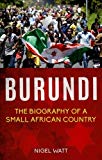Burundi: The Biography of a Small African Country
Burundi: The Biography of a Small African Country Reviewed by Dr. Wyndham Whynot, Department of History and Political Science, Livingstone College A typical American has minimal knowledge of Africa in general and, if pressed, could probably name some of the major countries such as Kenya, Nigeria, or South Africa, and some might be able to recall Rwanda. It is doubtful that Burundi would be mentioned. Many individuals do not realize that Burundians have suffered their own versions of genocide, not only during the Rwandan genocide, but also at other times. Nigel Watt’s Burundi: The Biography of a Small African Country seeks to bring attention to this little-known country. He divides the book into four parts, three sections relating to a specific chronological period and one topical section. The first section discusses geography and geographical regions and presents an overview of Burundi’s human geography. He introduces Burundi through a driving tour of the country, discussing the regions and the routes taken to visit significant cities, towns and villages, and noteworthy tourist locations. Watt then provides an overview of Burundi’s transportation infrastructure and Kirundi, the national language. Additionally, he discusses the role of religion in the country, noting that although Catholicism has been the dominant religion, Evangelical groups, the Quakers, and Muslims are increasing their presence gradually. (p. 20). This section concludes with a discussion of different cultural elements of Burundi such as literature, dance, and music. After briefly covering the pre-colonial and colonial history of Burundi and the three major ethnic groups, the Hutu, Tutsi, and Twa at the beginning of the second section, Watt turns to a discussion of the political difficulties facing the post-independence Burundian government. Initially governed by a monarchy, military officers eventually overthrew the king and placed the government under the control of a military officer serving as president. The author examines the administrations of three consecutive military presidents. He argues that the three presidents, all former officers, were unable to rule Burundi effectively and also failed to manage difficulties between Hutus and Tutsis. Watt explains how this failure eventually led to the unexpected Hutu victory in the 2005 presidential and parliamentary election, which increased Hutu leadership in Burundi. Moving forward, Watt discusses the Hutu revolts and the beginning of ethnic warfare and genocide that occurred in modern Burundi history. Both Tutsis and Hutus have engaged in extreme acts of violence toward each other at various times, yet Watt explains that some individuals of one ethnic group have protected members of the other. He notes that multiple attempts have been made to resolve these crises, including the use of foreign intermediaries such as Julius Nyerere of Tanzania and Nelson Mandela of South Africa to negotiate a political settlement to resolve the ethnic animosities that existed in the country and to establish a stable government. Despite some success with these crisis management efforts, Watt points out that many Burundian refugees chose to remain in Tanzania rather than return. In the last two sections of the book, Watt notes the recent success of Hutu political parties in winning presidential elections, which has shifted the power to the Hutus with the Tutsi on the outside looking in. As a result of negotiated agreements, the government does provide some seats for Tutsi parties and various splinter groups that split from the main Hutu party. In the final section, Watt examines the disturbing decision of the current Burundian president, Pierre Nkurunziza, to run for a third term, a step that has increased violence and resulted in significant restrictions on civil rights. Watt, who formerly worked in Burundi with several non-governmental organizations, offers a first-hand account of the country. Throughout the book, he includes quotes from oral interviews conducted with government officials, citizens, and other residents of Burundi. Additional research relies heavily upon secondary sources, many written by French authors. The book includes two maps, one of the country and the other of Bujumbura, the capital city, plus a limited number of Watt’s personal photographs. Anyone interested in learning about Burundi’s post-colonial political history and the impact of the Hutu-Tutsi ethnic division on the social and political life in Burundi would find this work useful. Scholars interested in an in-depth look at Burundian history that includes a comprehensive examination of the country’s pre-colonial era would be advised to use a different source. Despite the limited information on the earlier history of the country, this reviewer would recommend the book as a good introduction of Burundi’s modern political and social history. |



